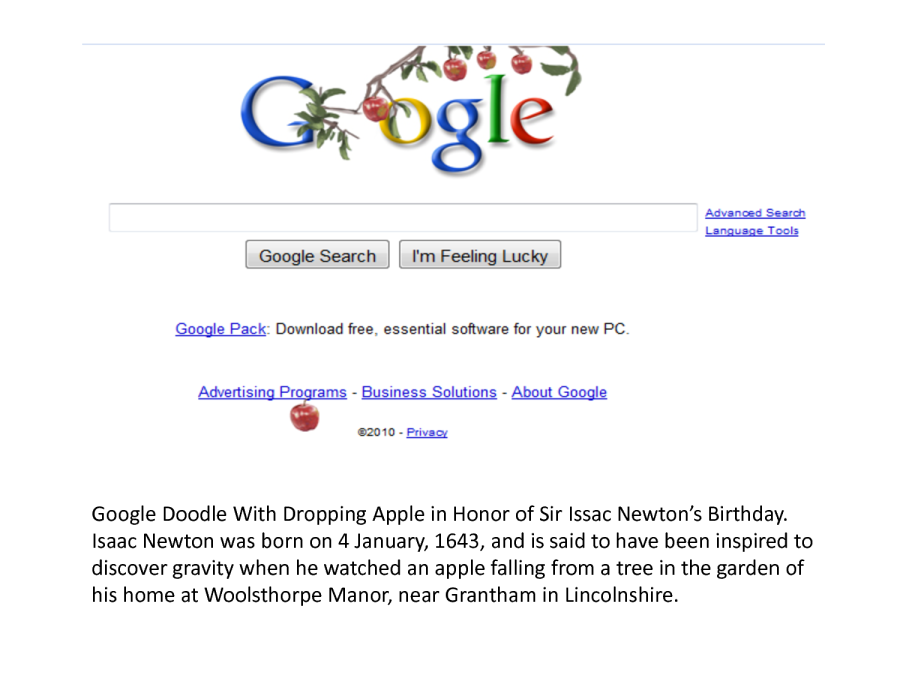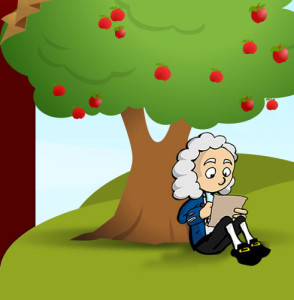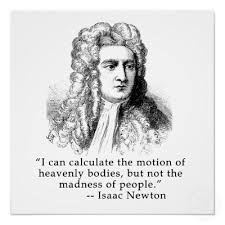Sir Isaac Newton Google Doodle: Theory Of Gravitation
Sir Isaac Newton Google Doodle

On January 4th 2010, the Google homepage was taken over by a Sir Isaac Newton Google Doodle celebrating what would have been the 367th birthday of the scientist. The Sir Isaac Newton Google Doodle appeared globally. The Sir Isaac Newton Google Doodle depicted an apple falling from a tree. This was the event which went on to inspire Newton’s theory of gravitation. The theory was to establish Newton’s position as one of history’s greatest scientific minds.
The Google logo was mostly unchanged in the Sir Isaac Newton Google Doodle, it appeared in its trademark colours and font style. However there was one notable difference in the Sir Isaac Newton Google Doodle, the first “O” of the logo was replaced by an apple tree branch. A total of five apples were depicted in the Sir Isaac Newton Google Doodle.

Newton was initially born on December 25th 1642, however with the adoption of the Gregorian calendar, which occurred in 1752, his birthday changed to January 4th. He was born in the Lincolnshire hamlet, Woolsthorpe-by-Colsterworth. His birth came three months after the death of his father, a wealthy farmer who was also named Isaac Newton. He was born prematurely and as a result was a small child. Newton’s mother, Hannah Asycough remarried when Newton was three years old to Reverend Barnabus Smith. Following the wedding Hannah went to live with her new husband, leaving Newton in the care of his maternal grandmother.
Between the age of twelve and seventeen, Newton was educated at The Kings School in Grantham before being removed. At this time his mother had become widowed for a second time and had returned to the family farm in Woolsthorpe-by-Colsterworth, where she attempted to make a farmer out of Newton. Newton is said to have despised farming. Newton’s schoolmaster at The Kings School pleaded with Hannah to allow Newton to continue his studies, she yielded and Newton re-joined the school, quickly becoming its top pupil.
As a result of his school performance, Newton joined the Trinity College of Cambridge in 1661. Newton graduated from the university in August 1665. Whilst his performance at the university was unremarkable, he quickly commenced to perform a series of experiments from his family home in Woolsthorpe. During these experimentations he developed his theories of optics, calculus and of gravitation. As a result of these theories he returned to Cambridge in 1667 as a fellow of Trinity.
During his lifetime, Newton made numerous contributions to four major fields, mathematics, optics, mechanics, gravitation and the classification of cubics. His contributions to the field of mathematics include the generalised binomial theorem, Newton’s identities, Newton’s method and made notable contributions to the theory of finite differences. Newton is also accepted to have been the first mathematician to confidentially utilise the power series and to revert the power series. Due to his mathematical contributions, Newton was appointed to the position of Lucasian Professor of Mathematics in 1669.
In those times, such an appointment had to be ordained by an Anglican priest. However, Newton protested against such an ordination. In the terms for the position of Lucasian Professor, it stated that such an individual was not to be active in the church, Newton used this clause to argue his case against the ordination. However in order for the exemption to be official, it required the permission of the King of England, then Charles II. Charles duly accepted Newton’s argument and he received the position without the need for the ordination.
Newton’s studies into optics resulted in the production of the world’s first refracting telescope. Hearing of his achievement the Royal Society asked for a demonstration in 1671. Between 1670 and 1672 Newton lectured heavily on the topic of optics, during this period he conducted experiments into the refraction of light. These experiments bore fruit, as he discovered and was able to demonstrate that the multi-coloured light which was produced by a spectrum, could be reconstructed into white light, by making use of a combination of a lens and a second prism.
Newton returned to the field of mechanics, specifically celestial, in 1679. His work in this field resulted in the 1687 publication of Principia. In Principia, Newton listed the three universal laws of motion. He stated that it was these three laws which had made the advances of the industrial revolution possible. Due to the strength of his laws, the ideas remained unchanged for 200 years and to this day remain the underpinning theories of much of the modern world’s non-relativistic technologies. Newton is widely accepted to have discovered gravity, initially he used the Latin word gravitas which means weight, to describe his findings. These findings resulted in defining the universal law of gravity.
During his later life Newton dedicated much time to the literal and symbolic interpretation of the Bible. These interpretations were compiled in the posthumously published works, “The Chronology of Ancient Kingdoms”, published in 1728 and “Observations Upon the Prophecies of Daniel and the Apocalypse of St. John”, which was published in 1733.
Newton served as a Member of Parliament on behalf Cambridge University, he served on two occasions during the years 1689-90 and 1701-02. However historians state that his contributions were limited. He was knighted in 1705, when Queen Anne visited the Trinity College of Cambridge, during April. Newton was the second scientist to receive knighthood, the first being Sir Francis Bacon. Newton developed a personal coat of arms following his knighting, the design featured a crossed pair of bones over a black background.
Newton did not marry and remained a bachelor throughout his life. He was found to have died in his sleep on March 20th 1727. Historians argue that due to the presence of mercury found in a sample of his hair, he could have died from mercury poisoning. Historians also argue that mercury poisoning would also describe his eccentricity in the later years of his life. Despite his atheist theology he was buried in Westminster Abbey, the renowned philosopher Voltaire was present at the ceremony.
Posthumously Newton achieved exceptional levels of fame. Albert Einstein is said to have kept a picture of him on the wall of his study. Bizarrely, Newton is the owner of the most expensive tooth ever recorded, for which he received “Most valuable tooth” in the 2002 Book of Guinness World Records. The record is a result of one of his teeth been sold in 1816 for a value of £730, this figure equates to roughly £25,000 in modern currency.
Numerous other leading scientists have received Google doodle’s honouring their achievements alongside this Sir Isaac Newton Google Doodle. These scientists include Nikola Tesla, Albert Einstein and Charles Darwin.

